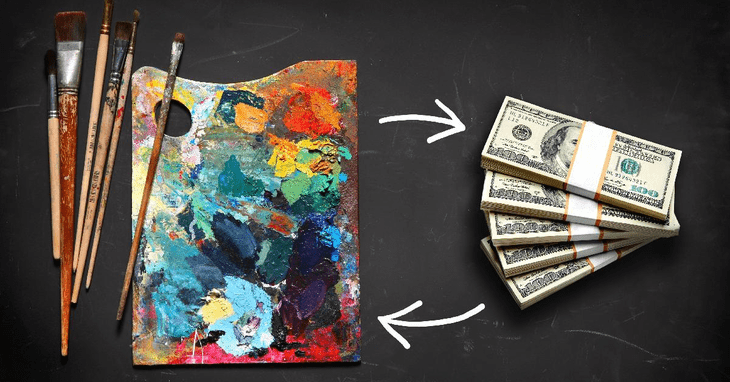Before you can sell your art, you first need to learn how to sell your art. Learn how to help a prospective client find the artwork that’s right for them.
Make your art public
If you’re at a gallery, or an art fair, or any other place where you’re exhibiting your art, you’re in a context which is designed for art appreciation. It’s not like approaching a stranger on the street – these people are here because they want to see works of art, and they’ll be open to discussion, almost expecting, sometimes hoping for, the opportunity to reach a deeper understanding of what they see.
How can you help them do this? Establish a friendly atmosphere. Be approachable, smile, and engage. There is a balance to be found here, and you won’t want to be pushy, insisting on holding the attention of someone passing by while they’re looking for ways to escape. Use your sensitivity and common sense to determine the level of enthusiasm that is ‘just enough’ – but don’t be shy about sharing your love for your work.
Ask potential client what attracted them first
Was it a particular colour? Then you might want to focus on works that include it.
Are they reminded of a vacation of which they have fond memories? Then you’ll want to concentrate on similar scenes.
Help them to develop this train of thought. Perhaps they find the colour soothing, or maybe they would like to tell you more about that vacation and why they enjoy remembering it.
The more you encourage them to elaborate and reach a clear understanding of their interest, the more they are likely to connect this developing interest to your work. Why?
Everyone likes to feel that they are speaking to someone who wants to hear what they say, and your discussion will help build up a rapport that is valuable in turning an interested passer-by into a client who might even come to act as a voice for your brand in the future.
You’re helping them to invest emotionally in the piece of artwork they’re examining. The more they feel that it relates closely to them, the more they are likely to respond and desire to continue that interaction – and purchase the piece for their home or office.
Find out if they’re looking for a piece to go in a particular place in their home or office
An awareness of the room and specific location will be very helpful to you in working out what might suit them – and what would not.
It’s true that we all hope our work will be appreciated purely on its own merits, and in many ways this is the case with those who love your work, but it is only fair to bear in mind the practical considerations involved.
However much a client loves your art, the fact is that if you want to sell your art the client needs to be able to imagine the place it would take in his life. It’s all very well to want to see that sculpture every day – but if it’s too big for a small apartment, it might not be a feasible option.
Be understanding of these limitations, and try to work with the potential buyer to find out what sort of space they’re envisaging, and what would work in it. If you honestly don’t believe that anything you have is appropriate, you can show other pieces form your portfolio or website that might be better alternatives, or offer to work on a commission basis.
Even if the art lover decides against purchasing your work in the end, he’ll remember your interest and efforts with gratitude – and if you have got him to sign up for your mailing list, he’ll be reminded from time to time of your work, making future sales possible.
You can use your imagination and your sense of colour, shape and place to help someone to buy your work and walk away knowing they’ve made the right choice.
Be interested in what they tell you
This isn’t just a buying-and-selling process. People who buy your work are likely to do so because they’ve developed an emotional connection to it. You can sell your art by discussing what they like about it, what it reminds them of. Listen to their responses and encourage them to talk. Try to think of these discussions as something that can reveal aspects of your creations that were previously hidden, even to you.
The fresh perspective of someone who is coming to your art with new eyes and no preconceptions attached to what they expect of you or your style can be valuable.
As a stranger they do not have the affection and background that often influences the reactions of the family or friends who more frequently come into contact with your work. they can be honest and frank in a way that others might not, lending you useful insight into your own pieces.
They bring their own experiences and memories to the viewing process, meaning that you can develop a sense of the myriad associations that might be attached to your creation, even without your knowledge.
All this is fascinating and fulfilling in its own right, and may also play a role in the works you create in the future. Look on these interactions with potential buyers as learning experiences, in which you can gain a deeper understanding of your work and the impact that it can have on others.
Share information about yourself
Are there anecdotes attached to some of the works that might be relevant? Stories about the place you created it, or where the idea initially came from, or what happened when you got half way through and realized you’d run out of ocher? Sharing these stories can help sell your art.
Not all artists are comfortable talking about their personal sources of inspiration or their own reactions to the piece in front of them. Many prefer the work to stand on its own merits, or feel that making statements about the meaning or background would place limitations on the potential interpretations of viewers in a way unintended during the creation of the piece.
It’s true that, as the artist who gave life to the work, you are in a position to influence the way in which it is viewed. However, this does not determine the ultimate impact that it has on a viewer.
By giving further information, and engaging in discussion about its creation and the elements that went into it, you are simply rounding out the picture, giving the viewer the chance to appreciate a greater level of depth.
You can decide in advance, or even while creating a particular piece, which aspects relating to it you would be comfortable sharing, and which you would not, so that when inquiry comes, you are ready to respond in a way that will engage a potential buyer – and help him to increase the positive feelings he already has for your work.
Create your fan circle
Treat someone who has already purchased a work without any encouragement in the same way. Show them the same interest, the same enthusiasm, that you would bring to the fore when addressing someone you hope to sell your art to.
Even if the person you’re talking to is that delighted art lover we described at the start, the one who knows they ‘just have to have this piece’ right from the second they see it, it’s still worth putting in the same effort you would expend on a potential buyer.
You might be able to guide them to buy a second piece, either then and there or in the future, or make them so enthusiastic about your work that they start telling their friends about you.
If someone has expressed genuine interest in your work, whether they actually purchased a piece or not, try to make sure that they’ll stay engaged.
Get their contact details, so that you can update them about the developments in your work and career.
Ask if you can take a photo of the two of you together – you can use it to remind you who this person is (remember to label it for your own information!) and, if they’re willing, you can post it on Facebook as a cheery update from the exhibition or fair, tagging the potential buyer so they’re involved in your professional Facebook presence.
Add their email to your mailing list, or find them on Facebook so they can like your business page.
If there was something specific you discussed that you’d like to follow up on – a work you don’t have there which you think the collector might be interested in, or an article that reflects something you talked about together, or a photograph of the place in the picture – then make sure to email them with those extra details, to keep the connection strong.
It really is worth putting effort into each interaction with anyone who expresses interest in your work. It might just develop into a lifelong relationship of mutual appreciation and benefit. And of course, help you sell your art!
Selling art online can be a daunting task but with a bit of research and some useful guidelines, abd this will be a profitable game.
Useful link: You can sell your art works on ART MARKET OF U

© Times of U

